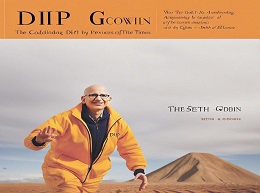The Myths of Creativity: The Truth About How Innovative Companies and People Generate Great Ideas

Unveiling "The Myths of Creativity": The Truth About How Innovative Companies and People Generate Great Ideas
"The Myths of Creativity: The Truth About How Innovative Companies and People Generate Great Ideas" by David Burkus is a groundbreaking book that debunks common misconceptions about creativity and innovation. Burkus, a renowned author and professor, draws from extensive research and real-world examples to provide a clear and practical understanding of how creativity truly works. This comprehensive review explores the key concepts of the book, enriched with examples to engage and inform readers.
David Burkus
David Burkus is a best-selling author, a sought-after speaker, and an associate professor of leadership and innovation. His work has been featured in numerous publications, and he is known for challenging conventional wisdom about business and creativity. With a strong academic background and practical insights, Burkus provides a unique perspective on the innovation process.
The Eureka Myth
One of the first myths Burkus tackles is the "Eureka Myth," the idea that creative insights come in sudden, dramatic moments of clarity. He argues that this belief is misleading and oversimplifies the creative process.
Example: Archimedes' "Eureka" Moment
While the story of Archimedes shouting "Eureka!" after discovering the principle of buoyancy is legendary, Burkus explains that such moments are often the result of prolonged thinking and problem-solving rather than spontaneous inspiration.
The Lone Creator Myth
Another prevalent myth is the "Lone Creator Myth," which suggests that creativity is the domain of solitary geniuses working in isolation. Burkus emphasizes that innovation is often a collaborative effort, involving multiple contributors and influences.
Example: Steve Jobs and Apple
Steve Jobs is frequently portrayed as a lone visionary, but Burkus highlights the contributions of other key figures at Apple, such as Steve Wozniak and Jony Ive. The development of the iPhone, for instance, was a team effort involving designers, engineers, and marketers.
The Network Effect
Burkus introduces the concept of the "Network Effect," which suggests that creativity thrives in diverse networks where individuals can exchange ideas and collaborate. He emphasizes the importance of building and nurturing such networks to foster innovation.
Example: The Invention of the Airplane
The Wright brothers' success in inventing the airplane was not solely due to their individual genius. They were part of a broader network of aviation enthusiasts and innovators who shared ideas and insights. Their collaboration with other pioneers, like Octave Chanute, was crucial to their breakthrough.
The Incremental Progress
Contrary to the myth of sudden, radical breakthroughs, Burkus argues that most innovations result from incremental progress. He suggests that small, continuous improvements often lead to significant advancements over time.
Example: The Development of the Light Bulb
Thomas Edison’s invention of the light bulb is often seen as a single monumental achievement. However, Burkus points out that Edison built on the work of previous inventors and made numerous incremental improvements to existing designs before achieving a commercially viable product.
Encouraging Diversity
Burkus stresses the importance of diversity in fostering creativity. A mix of different perspectives, backgrounds, and skills can lead to more innovative solutions.
Example: IDEO’s Design Teams
IDEO, a global design company, is renowned for its creative approach to problem-solving. They assemble diverse teams for each project, combining engineers, designers, and business experts to generate a wide range of ideas and perspectives.
Embracing Failure
Another key point Burkus makes is the necessity of embracing failure as part of the creative process. He argues that failure should be seen as a learning opportunity rather than a setback.
Example: Google’s "Moonshot" Projects
Google’s innovation lab, X, is known for its ambitious "moonshot" projects, such as self-driving cars and internet balloons. Many of these projects face numerous failures before achieving success. Google’s culture of embracing failure and learning from it has been instrumental in driving their innovative breakthroughs.
Implementing "Creative Constraints"
Burkus introduces the idea of "creative constraints," which are limitations or challenges that spur creativity. He suggests that setting boundaries can lead to more innovative solutions by forcing individuals to think outside the box.
Example: Pixar’s Animated Films
Pixar often sets creative constraints for its teams, such as specific themes or visual styles. These constraints challenge the teams to find unique and innovative ways to tell stories, resulting in groundbreaking animated films like "Toy Story" and "Inside Out."
Leveraging Analogies
Another practical strategy Burkus discusses is leveraging analogies. Drawing parallels between seemingly unrelated fields can inspire innovative ideas and solutions.
Example: Biomimicry in Design
Biomimicry, the practice of emulating nature’s designs, is a powerful example of leveraging analogies. Engineers and designers have developed innovative products, such as Velcro (inspired by burrs) and energy-efficient buildings (inspired by termite mounds), by studying and mimicking natural systems.
Corporate Innovation
Burkus provides numerous examples of how companies have successfully applied the principles of creativity to drive innovation. He highlights that fostering a culture of creativity is essential for sustained innovation.
Example: 3M’s Innovation Culture
3M is renowned for its culture of innovation, encouraging employees to spend 15% of their time on personal projects. This policy has led to the development of numerous successful products, including Post-it Notes and Scotch tape, by giving employees the freedom to explore and experiment.
Personal Creativity
The principles outlined in "The Myths of Creativity" are not just applicable to organizations but also to individuals seeking to enhance their creative potential. Burkus offers practical advice for individuals to cultivate creativity in their personal and professional lives.
Example: Writing a Book
For aspiring authors, Burkus suggests breaking down the writing process into small, manageable tasks. By setting daily word count goals and seeking feedback from a network of peers, writers can make steady progress and refine their work over time.
"The Myths of Creativity: The Truth About How Innovative Companies and People Generate Great Ideas" by David Burkus is an enlightening and engaging read that challenges common misconceptions about creativity. By debunking these myths, Burkus provides a clear and practical understanding of how creativity truly works, supported by extensive research and compelling real-world examples.
Through exploring concepts such as the network effect, incremental progress, and creative constraints, Burkus offers valuable insights and strategies for fostering innovation in both corporate and personal contexts. Whether you are an entrepreneur, a corporate leader, or an individual seeking to enhance your creative potential, this book provides the tools and inspiration needed to generate great ideas and drive innovation.
In a world where creativity is often seen as a mysterious and elusive quality, "The Myths of Creativity" demystifies the process and shows that with the right approach, anyone can harness the power of innovation. By embracing diversity, encouraging collaboration, and viewing failure as a learning opportunity, we can all contribute to a more innovative and creative future.













